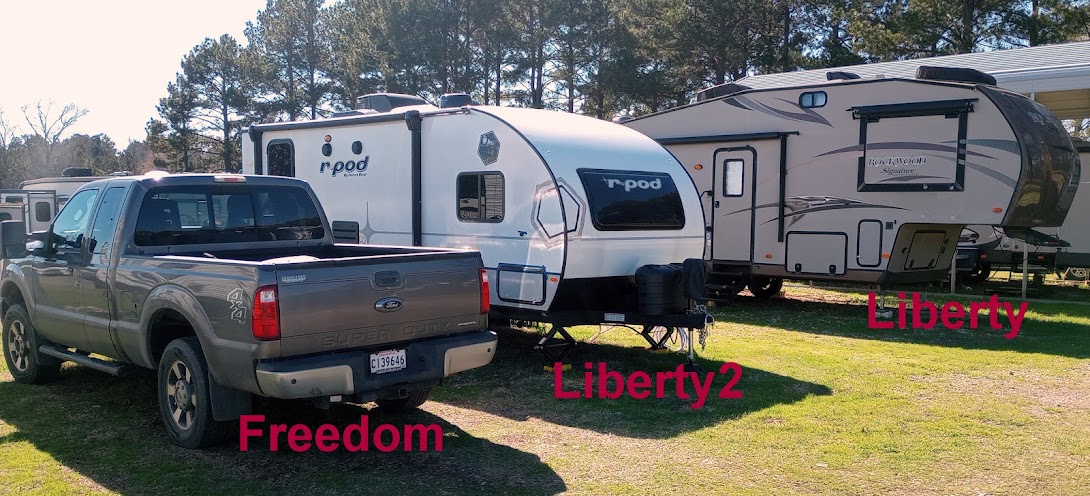Location: Pickwick Landing Dam Campground (TVA); Pickwick, Tennessee
There were two main items on my list of things to see and do in this area. One was to see the dam and Tennessee River and the other was to visit the Shiloh/Corinth Battlefield. Today is day 4 of my 4 day stay and I have done both.
I've thought about how to write a post about the battlefield and am unable to come up with a good way to present something so massive in size and importance. Instead, I will write a short summary of the events with some captioned pictures and maybe some personal opinions/views at the end.
The reason for the battle was the intersection of two major southern railroads located in Corinth, Mississippi, near the Tennessee border. The east/west route ran from the ocean port of Charleston, S.C. to the Mississippi River port of Memphis, Tenn. The north/south route ran from the Gulf of Mexico port of Mobile, Alabama to the Ohio River at Cairo, Illinois. Whichever side controlled this intersection controlled the major supply line for the south.
 |
| This is the railroad intersection in Corinth. That small square of railroad track cost the lives of many people. |
About 1 year after the war began at Fort Sumter, the south moved 44,000 troops into Corinth to defend the intersection. After the north won battles at Nashville, Fort Henry and Fort Donelson they were in control of the intersection of the Ohio and Tennessee Rivers. The north initially brought 40,000 men to Shiloh by way of riverboats. They unloaded at a place called Pittsburgh Landing, about 20 miles from Corinth.
 |
| This is Pittsburgh Landing today. The stairs on the bottom left lead to the Shiloh National Cemetery. |
The south took the fight to the north by leaving Corinth and marching the 20 miles to Pittsburgh Landing. They arrived before daylight and the fight began. The south easily pushed the north back early on in the morning. Some say, many of the southern soldiers stopped fighting so they could eat the breakfast that the north had been cooking before the fight. Even so, the north was pushed back to the river landing before they held their ground. During the night thousands of fresh northern reinforcement troops arrived. The battle resumed the next morning and with fresh troops, the north pushed the southerns all the way back to Corinth. The north laid siege to the city. After a little less than one month, the living conditions were so bad in Corinth, the southerns abandoned the city and retreated to Tupelo, MS. In late summer, the south tried to retake the city but was defeated. All total, about 30,000 dead and wounded in the fights at Shiloh and Corinth.
You can visit the Shiloh Battlefield. Not long after the war ended, survivors on both sides met with historians to record what happened and where it happened. The battle is recorded in detail. There are monuments located everywhere throughout the battlefield commemorating what happened at that location. You can look across an empty field and see a monument in the distance with only a mowed path to reach it. It would take weeks to see and absorb everything. I only had one day.
 |
| One of the monuments scattered around the battlefield. |
 |
| Another monument on the battlefield. Each state who sent men to the battle erect their own monument. They design it, mostly however they want. |
 |
| This is the location where the Union anchored a couple gun boats on the Tennessee River to shell the southern positions. |
There is also a National Cemetery located on the high ground near the actual Pittsburgh Landing. Most of the graves only have a small square marker with a number on top since the identity of the soldier is unknown. Although there are a few southern soldiers buried in the cemetery, most were buried in mass graves out on the battlefield. The southern soldiers laid on the battlefield for days or weeks before being buried in shallow trenches. Most of the time, locals were the ones doing the southern burials. Eyewitness accounts tell of northern soldiers going onto the battlefield to retrieve the bodies of northern soldiers while ignoring the body of a southern soldier near by.
 |
| The entry path to the National Cemetery on the Shiloh Battlefield |
 |
| The cannon monument is supposedly the spot where General Grant had his headquarters. |
 |
| It's a peaceful place but you can feel the unrest in the air. |
 |
| This gives you an idea of how many "unknowns" are buried here. |
The reason there are so many large civil war monuments and statues in the south is simple, but has been misconstrued lately. At the time most of those monuments were put up, the family members of the dead southern soldiers considered them as a "headstone" or "marker". Most never knew where their family member died or was buried. Now, people are removing those markers in order to erase the memory. To a lot of southerners it is equal grave desecration.
Tomorrow is moving day and I'll be headed to Joe Wheeler State Park on Wilson Lake between two TVA dams. This has been a nice campground.
Ya'll take care of each other. Maybe I'll Cya down the road.




Excellent report tonight. Thank you.
ReplyDeleteYou're welcome Barney
DeleteGreat informative post....now on my list of places to visit! Thanks
ReplyDeletePickwick Dam Campground is a good base camp location. Be safe out there.
DeleteVery good! I particularly enjoyed the photos and commentary.
ReplyDeleteI'm glad you liked it. It's an interesting but strange feeling place on the battlefield.
Delete